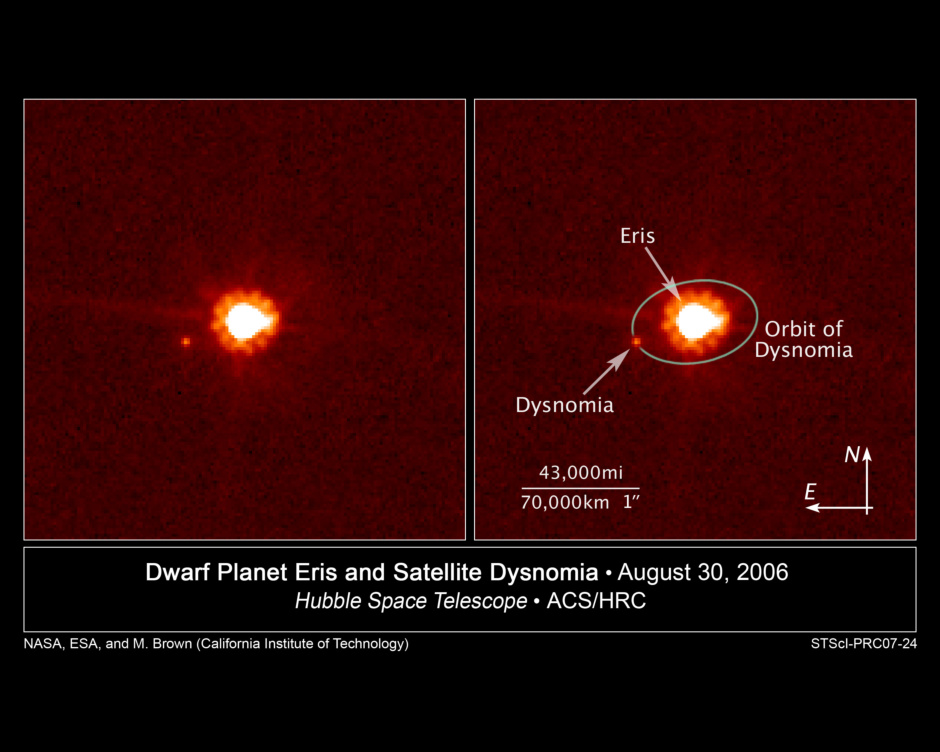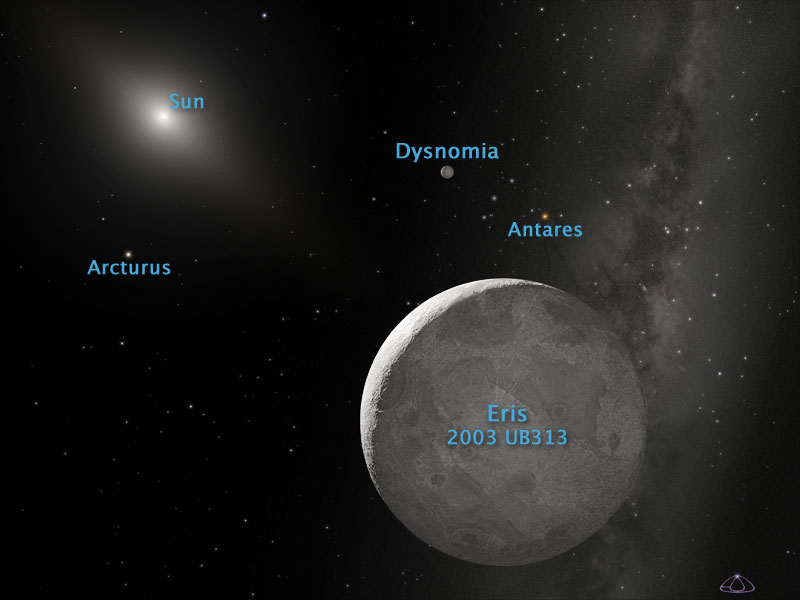허블우주망원경과 W.M.Keck천문대는 태양계에서 가장 큰 크기를 가지고 있는 난장이 행성인 에리스(Eris)의 질량을 정밀하게 측정하기 위한 협력을 하였다.
에리스는 이전에 해왕성 너머의 카이퍼 벨트에서 가장 큰 것으로 알려져 있던 플루토(Pluto, 행성으로 인정받았을 당시에는 명왕성으로 번역되었음)보다 1.27배의 질량을 가지고 있다.
2006년의 허블 관측에 의하면 에리스는 플루토보다 약간만 큰 것으로 예측되었다. 그러나 질량은 에리스 주위를 돌고 있는 달인 디스노미아(Dysnomia)의 공전궤도상 운동을 관측함으로서만 측정 가능하다
여러 장의 디스노미아(Dysnomia)의 공전궤도 운동이 허블과 Keck에 의해 촬영되었다. 캘리포니아 기술연구소의 천문학자인 마이크 브라운과 그의 동료들은 이번 주 과학잡지에 디스노미아의 공전운동 주기가 거의 16일이라고 발표하였다.
여기에는 또한 디스노미아가 에리스와 카이퍼 벨트상의 다른 천체와의 충돌에 의해 발생했다는 견해가 함께 실려 있다.
일반적으로 이처럼 중력에 의해 포섭된 천체의 공전궤도는 이심률이 큰 타원형으로 나타나는 것으로 예측된다.
플루토의 위성뿐만 아니라 지구의 달 역시 다른 천체와의 충돌로 인해 생성된 것으로 여기지고 있고 이러한 충돌로부터 발생한 파편들이 공전궤도상에서 합체를 거듭하면서 위성으로 생성되는 것이다.
브라운은 질량과 직경을 비교함으로써 에리스의 밀도가 1세제곱 센티미터당 2.3그램이라고 계산하였다.이러한 결과는 플루토, 카이퍼벨트 상의 큰 천체 중 하나인 2003 EL61, 그리고 원래 카이퍼벨트 천체였으나 해왕성에 포섭된 것으로 보이는 위성 트리톤(Triton)의 밀도와 매우 유사한 것이다.
이러한 높은 밀도는 이들 천체가 단순히 얼음으로 구성된 것이 아니라 아주 큰 암석 덩어리로 이루어져 있음을 나타낸다.
2005년 에리스의 발견(원래 닉네임은 제나(Xena)이며 공식 등재된 명칭은 2003 UB313이다)은 즉각 명왕성(Pluto)의 행성으로서의 자격에 대한 격렬한 논쟁을 야기시켰는데, 만약 명왕성이 계속 행성으로서의 자격을 유지하게 된다면 에리스 역시 10번째 행성으로 등재되어야 할 수 밖에 없는 상황이었다.
그래서 2006년 개최된 국제천문학회에서는 태양계에서 난쟁이 행성(dwarf planets)이라 부르는 새로운 범주의 천체그룹을 만들었다.
난쟁이 행성들은 태양계 주요 행성과 마찬가지로 정역학적 평형상태(이 천체는 천체 자체의 경직을 극복할만한 충분한 중력을 가지고 있어야 하며, 구체형상을 갖추어야 한다.)를 갖추어야 하지만, 태양계의 다른 주요 행성들과는 달리 그들의 공전궤도를 따라 작은 암석부스러기들이나 파편들이 존재하고 자체 중력이 이들을 쓸어낼만큼 충분하지는 않은 것을 말한다.
<에리스와 그 위성의 상상도> 지구에서 에리스까지의 거리는 약 160억 킬로미터이다.
참고 : 에리스를 비롯한 태양계 작은 천체에 대한 각종 포스팅은 아래 링크를 통해 조회할 수 있습니다.
왜소행성 : https://big-crunch.tistory.com/12346957
소행성 : https://big-crunch.tistory.com/12346956
혜성 : https://big-crunch.tistory.com/12346955
유성 : https://big-crunch.tistory.com/12346954
원문>
NASA's Hubble Space Telescope has teamed up with the W.M. Keck Observatory to precisely measure the mass of Eris, the largest member of a new class of dwarf planets in our solar system. Eris is 1.27 times the mass of Pluto, formerly the largest member of the Kuiper Belt of icy objects beyond Neptune.
Hubble observations in 2006 showed that Eris is slightly physically larger than Pluto. But the mass could only be calculated by observing the orbital motion of the moon Dysnomia around Eris. Multiple images of Dysnomia's movement along its orbit were taken by Hubble and Keck.
Astronomer Mike Brown of the California Institute of Technology in Pasadena, Calif. and colleagues also report in this week's Science Magazine that Dysnomia is in a nearly circular 16-day orbit. This favors the idea that Dysnomia was born out of a collision between Eris and another Kuiper Belt object (KBO). A gravitationally captured object would be expected to be in a more elliptical orbit.
The satellites of Pluto, as well as the Earth-Moon system are also believed to have been born out of a collision process where debris from the smashup goes into orbit and coalesces into a satellite.
By comparing the mass and diameter, Brown has calculated a density for Eris of 2.3 grams per cubic centimeter. This is very similar to the density of Pluto, the large Kuiper Belt object 2003 EL61, and Neptune's moon Triton which is likely a captured KBO. These higher densities imply that these bodies are not pure ice but must have a significant rocky composition.
The discovery of Eris in 2005 (originally nicknamed Xena, and officially cataloged 2003 UB313) prompted a debate over the planetary status of Pluto because astronomers realized they would have to call it the "10th" planet if Pluto retained its own planetary status, which was already under debate. This led the International Astronomical Union, in 2006, to make a new class of solar system object called dwarf planets. These are spherical bodies in hydrostatic equilibrium (objects that have sufficient gravity to overcome their own rigidity and form a spherical shape) like the planets, but unlike the major planets in the solar system, they have not gravitationally cleared out the neighborhood of particles and small debris along their orbits.
CONTACT
For more information, contact:
Ray Villard
Space Telescope Science Institute, Baltimore
410-338-4514; villard@stsci.edu
Robert Tindol
California Institute of Technology, Pasadena, Calif.
626-395-3631; tindol@caltech.edu
Laura K. Kinoshita
W.M. Keck Observatory, Kamuela, Hawaii
(808) 881-3827; newsletter@keck.hawaii.edu
Mike Brown
California Institute of Technology, Pasadena, Calif.
626-395-8423; mbrown@gps.caltech.edu
'3. 천문뉴스 > 허블사이트' 카테고리의 다른 글
| SDSS J0737+3216, SLACS J0737+3216 (0) | 2007.10.08 |
|---|---|
| NGC 3603 (0) | 2007.10.07 |
| 소행성 세레스와 베스타 (0) | 2007.09.21 |
| 허블이 촬영한 목성의 대기변화 (0) | 2007.09.20 |
| 별들의 요람 NGC 4449 (0) | 2007.09.19 |

